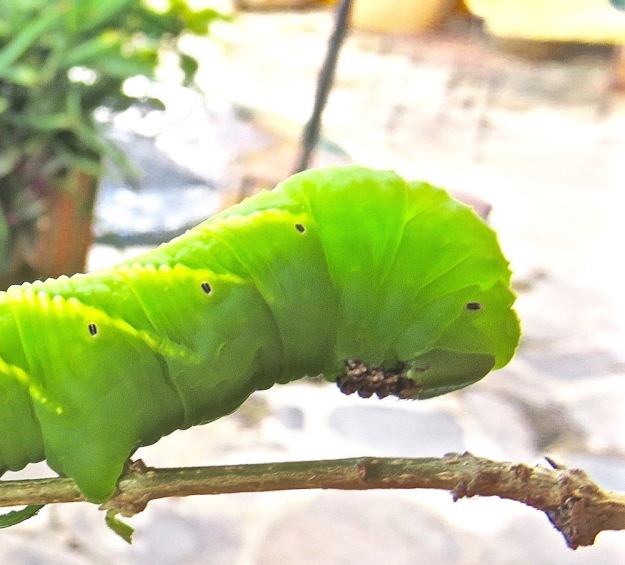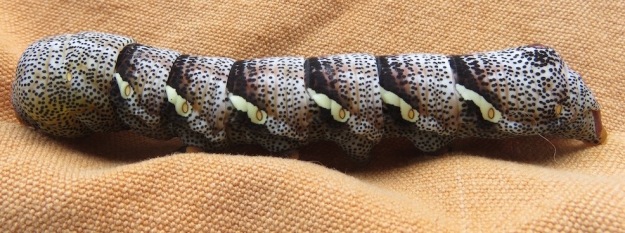Change, Change, Change
For the fourteen years I’ve been in Mexico, a bright green caterpillar (actually, the larval stage of the hornworm at this stage) has invaded my Virginia Creeper vines. It wouldn’t be much of a problem except for the fact that they poop lots of black pellets about 1/2 inch in diameter directly onto my glass tabletop and all over the terrace floor. I can never see them against the green of the foliage, so three or four times a year, Pasiano is recruited to use his keen eye to discover them and relocate them to my houseless extra lot next door.



I think his/her little green tail looks like one of those little brushes that is used in place of floss or a toothpick to clean between teeth.
If we don’t catch them during the green stage, they begin to morph into a creatures you wouldn’t believe were stages of the same being.
 This goofy little guy looks like he has crystals coming out of the top of his head. (Click to enlarge)
This goofy little guy looks like he has crystals coming out of the top of his head. (Click to enlarge)
 And this guy was caught at the same time we found the littler guy above.
And this guy was caught at the same time we found the littler guy above.
 This shot shows their size in relation to each other. The larger one is four or five inches long. Their heads look like the rolled part of an uninflated balloon and are translucent and polka dotted. The racing stripes add an extra flair in the littler guy whereas the larger one looks more sedate in his brown and white striped pale gray suit. Two different caterpillars or stages of the same creature? And, are they later stages of the green larva? If so, why is the one guy smaller? Questions, questions.
This shot shows their size in relation to each other. The larger one is four or five inches long. Their heads look like the rolled part of an uninflated balloon and are translucent and polka dotted. The racing stripes add an extra flair in the littler guy whereas the larger one looks more sedate in his brown and white striped pale gray suit. Two different caterpillars or stages of the same creature? And, are they later stages of the green larva? If so, why is the one guy smaller? Questions, questions.


This is the next stage of worm that we found. By now, I have discovered that it is a Hornless Hornworm (Acemon Sphinx) and that they lose the little horn on their rear end (you can see the detail on the first green stage above) after their first molt and it is replaced on each of the subsequent larval stages with an eyespot that you can clearly see in the picture below.
 That one eyespot on the tail end seemed spookier when I thought it was a cyclops eye on the head of the hornworm!
That one eyespot on the tail end seemed spookier when I thought it was a cyclops eye on the head of the hornworm!
There is a rather long and unbelievable story that goes with this stage of the caterpillar that I will tell at a later time. In fact, this is the one hornworm that became my “mascota” (pet.)
The most interesting part of this story is what this caterpillar turns into. So far as I know, I’ve never seen the insect stage–perhaps because I am too insistent that Pasiano removes all the larva to relocate them. I have just this year discovered that they actually turn into hummingbird moths that are avid pollinators of many of the flowers I grow. They are also beautiful–often being mistaken for hummingbirds. I don’t think it is fair for me to download a picture of the moth, since all of the photos above were taken by me and if I had been more aware of anything other than my Virginia creeper, I would have known that it might be worth putting up with the worm poop to be able to see the hummingbird moth.
So hereafter, I vow that I will not relocate any more hornworm larva or caterpillars at any stage. And it may take another year, but I promise to take a picture of the first hummingbird moth that I see.
THE END!!!!
https://dailypost.wordpress.com/dp_photo_challenge/change-2015/


I was really mistook a hummingbird moth for a hummingbird. Someone with better eyes than mine had to point out that for a bird, that creature had far too many legs 🙂 They do really look like hummingbirds.
LikeLike
I actually did mistake a hummingbird moth for a hummingbird. Someone with better eyes than mine had to point out that for a bird, that creature had far too many legs 🙂 They are a most unique and interesting insect and I rather like them, even though on the whole, I don’t much like insects.
LikeLiked by 1 person
Did you take a picture of one??? i am dying to but did myself in getting rid of all their babies. Some must have survived, though, because somebody is laying those eggs and making those little fellers and I don’t think it is a surrogate mother.
LikeLike
Hmm. Seem to have duplicated myself. Hmm.
LikeLike
Ha. I was reading down in my messages from the top and was trying to figure out what you meant by the fact that you had duplicated yourself! Three messages later, I understood. I would have removed one, but then no one would understand your last message, so decided to let them stand.
LikeLike
Loved the science lesson… but what will these “worms” do to your flowers as you await their beautiful new self?
LikeLike
They’re creepy and fascinating.
LikeLiked by 1 person
We’ve only ever seen the big green guys in our tomatoes garden. The hummingbird moths have come to our bee balm — I really thought the first one was a baby hummingbird, but it had feathery antenna! They hover and visit floral tubes just like a hummingbird — fascinating!
LikeLiked by 1 person
Pingback: More Hummingbird Moth Larvae Photos | lifelessons – a blog by Judy Dykstra-Brown